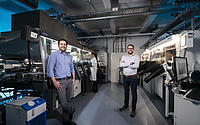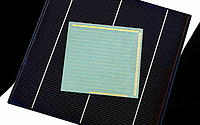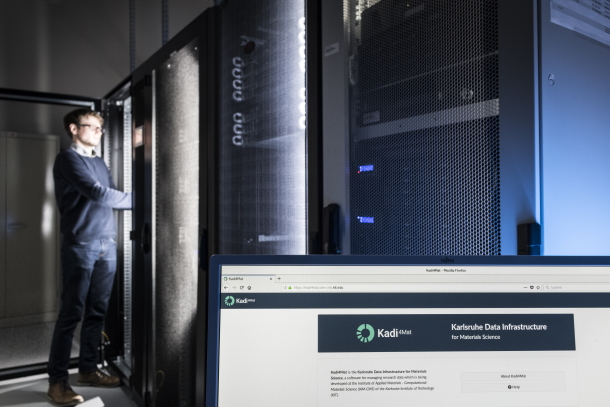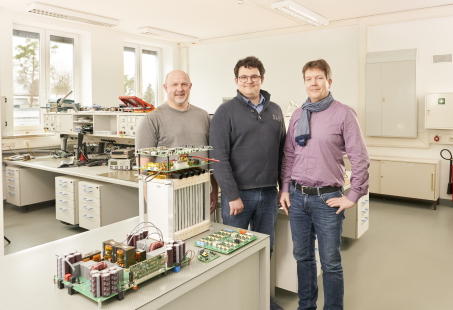- Energy
- Climate, Environment & Health
COUNTERACTING CLIMATE CHANGE WITH TANDEM SOLAR CELLS

At first glance, a tandem may seem bulky and unwieldy. At second glance, it offers a decisive advantage over an ordinary bicycle: it runs better together! Due to the double occupation, more power is available to significantly increase the drive of the bike and to cover further distances.
KIT researchers are taking advantage of the fundamental "tandem concept" to develop next-generation solar cells. Established silicon solar cells have undergone decades of progress in their technological development and are now reaching their limits in terms of conversion efficiency from light to electrical energy. "The optimization potential will be exhausted in the near future. Every additional percent of efficiency means an enormous development effort," explains Junior Prof. Ulrich W. Paetzold, tenure-track professor and head of the Next Generation Photovoltaics working group at KIT. To escape this impasse, new and more efficient concepts are needed. Solar cells based on perovskite semiconductors are of particular interest to the scientific community, as they have shown an incredibly rapid increase in efficiency over the past ten years.
Perovskite solar cells are particularly promising in combination with another solar cell material, such as crystalline silicon or established thin-film semiconductors like CIGS (copper, indium, gallium, selenide) in form of a tandem solar cell. This is due to the fact that perovskites use the blue-purple high-energy light in the solar spectrum more efficiently than other solar cells, which primarily convert red and infrared light efficiently into electrical energy. Thus, the use of multiple solar cells with different efficient absorption ranges provides the higher efficiencies than for individual solar cells.
Simply put, the tandem solar cell can be thought of as a silicon+ solar cell (or CIGS+ solar cell). The use of silicon or CIGS in the tandem solar cell is attractive because the wheel does not have to be reinvented and an established production technology can be used as the basis for the tandem solar cell. Enthusiasm for this concept has already spread from the scientific community to the German Photovoltaic Industry. Even though there are still some challenges to overcome, such as the insufficient long-term stability, numerous companies (machine builders, module manufacturers, material suppliers) are already looking forward tpo the technology, for example the company Oxford Photovoltaik, which is currently setting up an initial pilot line in Brandenburg.
The bottleneck in the development of the tandem solar cell currently relates primarily to the perovskite solar cell on the front side. "We have developed a tandem prototype that we are currently using to improve the efficiency of the silicon solar cell from just over 20 percent to 27.8 percent. This also provides us with evidence that the technology can already outperform the best silicon solar cell ever measured. The tandem technology works," says Junior Prof. Paetzold, describing the current status. His team is working at all levels to further advance the tandem technology and optimize the yield under real light conditions. An important research aspect is the upscaling of the perovskite solar cell from the small laboratory scale to application-relevant areas for solar modules. A particular challenge for the upscaling is the uniform coating of all solar cell layers on the substrate. "Homogeneous deposition of solar cell layers by rotational coating works perfect in the lab on small areas. Industrially, it is not applicable because the method leads to strong inhomogeneity in the deposition already on areas of a few square centimeters," explains Ph. D. Tobias Abzieher, a scientist in the field of vacuum deposition of perovskite solar cells and member of the research team. His approach to solving the problem: vapor deposition of the individual solar cell layers in a vacuum. "Vapor deposition is a standard approach in the industry because of its outstanding homogeneity and it also allows very good control over layer thickness and material composition of the layers involved. The fact that we have developed a fully evaporated perovskite solar module is unique worldwide and sets our work apart from other research," Ph. D. Abzieher proudly reports.
The development of cost-effective and scalable manufacturing processes, such as vacuum deposition, but also the development of innovative deposition processes from the liquid phase is fundamental to the Karlsruhe research. To enable tandem technology for commercial application, the team collaborates with a variety of national, european and international companies. The various facets of the research are strongly supported by the Helmholtz Association, the German Federal Ministry for Economic Affairs and Energy, the German Federal Ministry of Education and Research and the European Research Framework Program.
The tremendous progress of perovskite research is already catapulting the semiconductor material to the forefront of hopes for high-performance, low-cost solar cells of tomorrow. It is not without reason that perovskite photovoltaics is one of the most rapidly developing research fields worldwide. The researchers of KIT expect the tandem technology to be available on the market already by the middle of the current decade.
"I expect perovskite silicon tandem solar cells to be used in large-scale photovoltaic power plants in the future. In the laboratory, the technology's efficiency is expected to reach 33 percent in the next few years, far surpassing the silicon photovoltaics established on the market right now."
Further links
Pictures: Markus Breig / KIT






